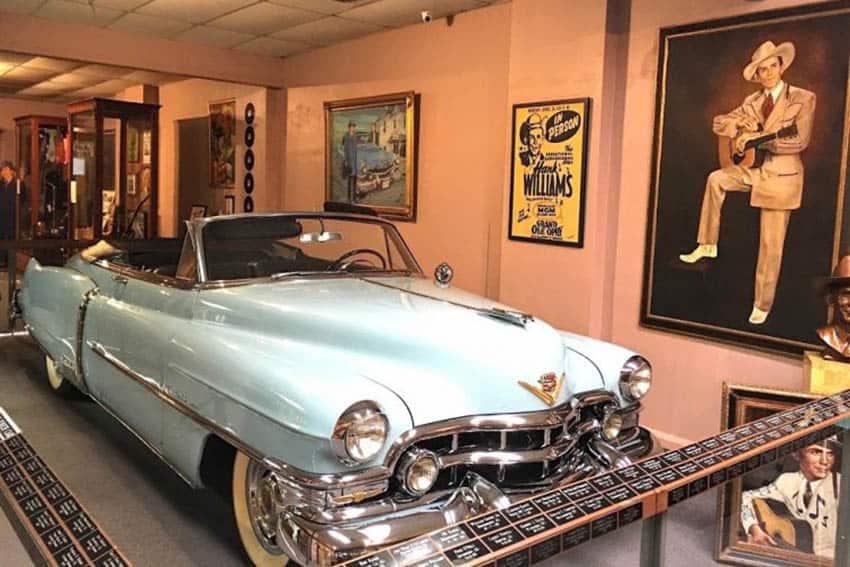
Honoring the Short Life of Country Music Legend Hank Williams in Montgomery, Alabama
By Jackie Sheckler Finch
Senior Travel Writer
Slumped in the back seat of a baby blue Cadillac speeding through a dark night, Hank Williams died on New Year’s Day, 1953.

He was 29 years old.
The country music legend was on his way to a concert in Canton, Ohio. Somewhere in West Virginia, Williams’ young driver became worried about the lifeless body draped in a navy-blue overcoat. By then it was too late.
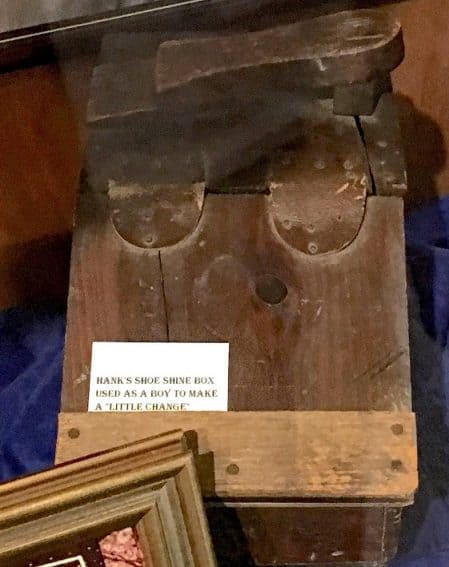
Carried into an emergency room, Williams was pronounced dead on Jan. 1, 1953. His heart had given out.
Nearly 28,000 fans attended the Jan. 4 funeral in Montgomery, Alabama. Williams was laid to rest in one of his white stage suits, a small white Bible in his hands.
He is buried in nearby Oakland Annex Cemetery, where a public memorial service is held every New Year’s Day.
More than six decades later, you can see the 1952 Caddy that carried Williams to his death and the blue serge suit he wore on that cold night.
The museum was the creation of a man named Cecil Jackson who had attended Williams’ funeral as a teen and swore to someday create a museum for “the greatest singer and songwriter of all time.”
“This was my Dad’s dream,” said Beth Petty, director of the museum that her father founded. Cecil Jackson died in 2010 but his daughter has vowed to continue the attraction that draws people from around the world.
The doors of the Hank Williams Museum opened on Feb. 8, 1999, in Montgomery, Alabama, where Williams had spent the better part of his life.
Drawn to Music From the Start
Born on a farm in Mount Olive, Alabama, on Sept. 17, 1923, Hiriam (as spelled on his birth certificate) “Hank” Williams was the second child of Lon and Lillie Williams. His father was a World War I veteran who was hospitalized for war stress for most of the boy’s early life. A small child afflicted with spina bifida, Williams seemed drawn to music from the beginning, singing in church choirs as a child.

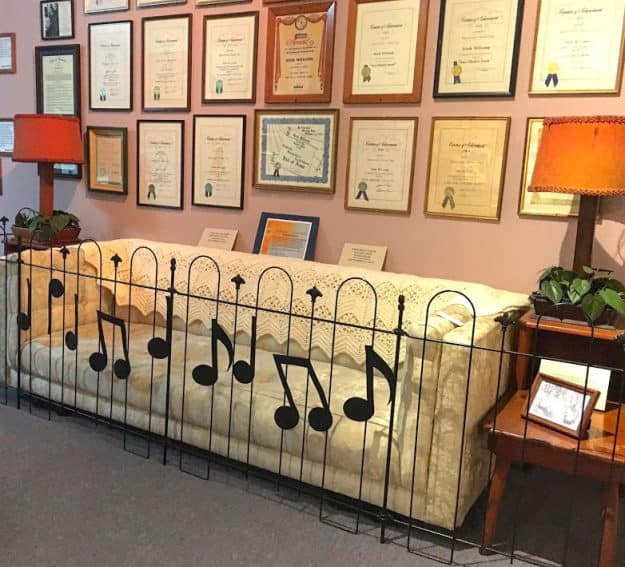
One of his best friends was Rufus Payne, a black street musician known as “Tee-Tot.” Williams later credited Payne with giving him “all the music training I ever had.”
Williams and his mother moved to Montgomery in 1937. He was only 14 when he entered an amateur talent contest at The Empire Theater and won $15 first place for singing his original “WPA Blues.”
Quitting School at 16
At age 16, Williams quit school and turned to his music career with a vengeance. A regular on local radio shows, he played at almost every high school auditorium, honky tonk, and fair in the area, backed by his band, the Drifting Cowboys.
In 1944, Williams married Audrey Mae Sheppard, an Alabama country girl with a two-year-old daughter from a previous marriage. Learning to play stand-up bass, Audrey joined the band and made some recordings herself. But it was Hank Williams that the fans wanted.
In all, Williams recorded 225 songs and wrote 128 of them. Under the pseudonym “Luke the Drifter,” he tried to work out his demons in gospel themes and a series of recitations.
On a warm night in June 1949, Williams reached the pinnacle – his debut at Ryman Auditorium for the Grand Ole Opry. Less than four years later he would be gone.
By mid-1952, his life was on the skids. Audrey filed for divorce and took their son, Randall Hank Williams Jr. Wracked with back pain, Williams tried to ease his misery with whiskey and morphine, prescribed and often administered by doctors.
Opening the Hank Williams Museum
Over the years, Jackson collected whatever Hank Williams memorabilia he could find, planning to someday open his museum. After retiring, Jackson figured the time had come to share all he owned, plus a wealth of things that had been donated or loaned.
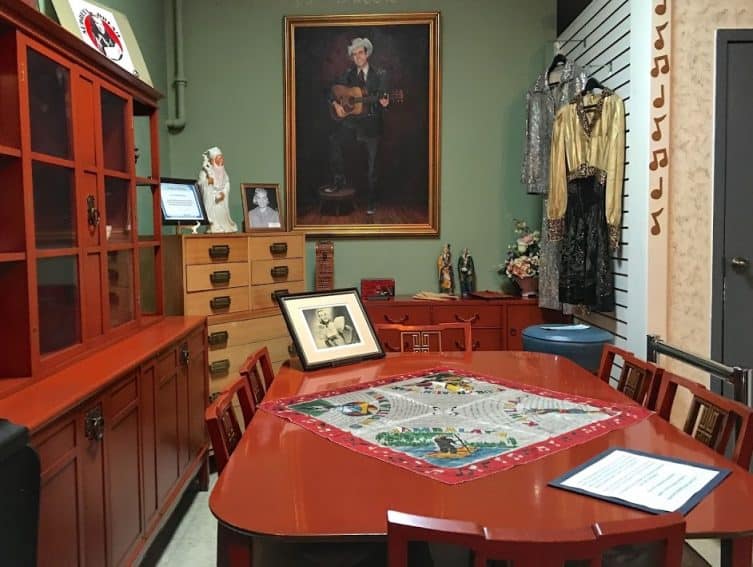
The center of attention, of course, is the sparkling Cadillac where Hank Williams breathed his last. The restored automobile is on loan from Hank Williams Jr.
The piano that was in Hank and Audrey’s Williams’ home also is showcased, as are other family furniture plus the suits and boots worn by Williams and the hand-painted neckties he favored.
There’s the saddle Williams used to ride his horse Hi Life and the old fiddle he played. You can see a partially empty tube of Pepsodent toothpaste and other items the singer had with him on that last ride.
A mannequin models the blue, western-style outfit the singer was wearing when he died. Williams had slipped off his white cowboy boots and was wearing slippers for that final trip.
Shortly after celebrating the New Year of 1953, mourners began flocking to Montgomery. They lined the streets and congregated outside a boardinghouse where a silver casket sat.

So many people came to pay tribute that the funeral couldn’t be held in a church. The service had to be moved to the biggest facility in town, the Municipal Auditorium.
Ironically, that was the very auditorium where the fallen star had performed so many times. Now it was where Hank Williams, the Drifting Cowboy, would be bidding farewell for his last journey.
Grand Ole Opry stars arrived in a specially chartered plane. Among the Opry entertainers were Jimmy Dickens, Carl Smith, Webb Pierce, Bill Monroe, Ray Price, and June Carter. Loads of flowers were delivered, including two guitar-shaped floral arrangements that stood on each side of the coffin.
At 1 p.m. the casket was brought in and opened at 1:15. The Drifting Cowboys stood by as a guard of honor. Hundreds filed by to pay their respects.
At 2:30 p.m. the auditorium doors were closed and the service started with Ernest Tubb singing “Beyond the Sunset.” A gospel quartet, the Statesmen, who would later sing at Elvis Presley’s funeral, sang “Precious Memories.” Possibly the only black quartet to perform at a prominent white funeral in Alabama prior to the civil rights era, the Southwind Singers sang “My Record Will Be There.”
Roy Acuff performed Hank’s popular song, “I Saw the Light.” Red Foley’s voice wavered and tears flowed down his face as he sang “Peace in the Valley.” Foley and Williams had made a promise that whoever died first, the other would sing at his friend’s funeral.

At the museum, visitors can sit in a small room and watch videos of Williams performing. A 1940s jukebox sits in one corner. The museum has a slew of Williams’ recordings, ranging from rare and fragile old 78s to the stereo LP albums issued long after he died. Other exhibits showcase people and kinfolk who were close to Williams.

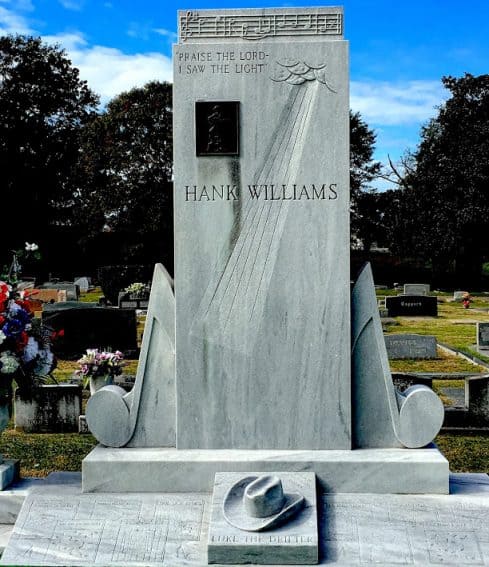
“My Dad always said it was very shocking when Hank died,” Perry said.
“You never think someone is going to die when they’re only 29 … Hank was a genius and that’s why people still remember him after all these years.”
For more information: Contact Hank Williams Museum at
(334) 262-3600
www.thehankwilliamsmuseum.net or the Montgomery Convention & Visitors Bureau at (800) 240-9452, www.visitingmontgomery.com
- Buddy Holly Museum in the Heart of Texas - September 15, 2024
- American Melody Cruise: Perfect! - January 29, 2024
- Spanish Museums Honor Picasso on 50th Anniversary - December 19, 2023



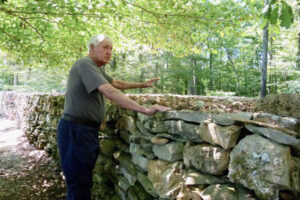


Thanks for letting us know the new number. A terrific museum!
The phone number for Hank Williams Museum needs to be updated. The number on the post is incorrect. The correct number is 334-262-3600.